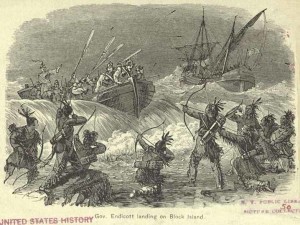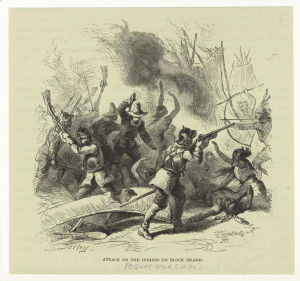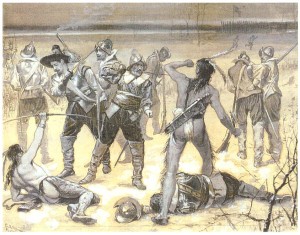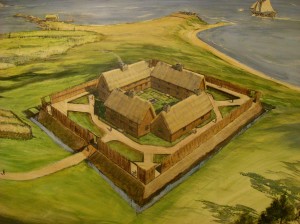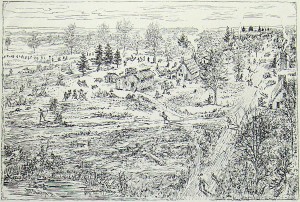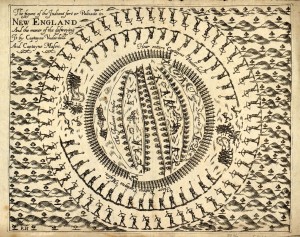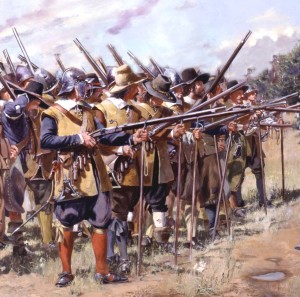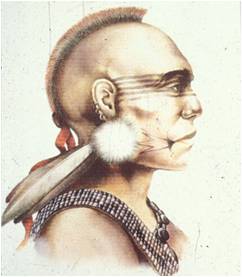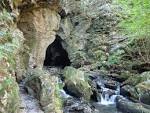Battlefield Sites
Pequot War Battlefield Sites
The National Park Service American Battlefield Protection Program defines a battlefield as a site where armed conflict, fighting, or warfare occurred between two opposing military organizations or forces recognized as such by their respective cultures.
Massachusetts Bay Punitive Expedition (April 24, 1636)
Block Island (New Shoreham), Rhode Island
Massachusetts forces under John Endicott attack the Manisean Indians on Block Island in retaliation for the death of Captain John Oldham. Following the invasion of the island the Massachusetts Bay men sail to Saybrook Fort and from there sail to the Pequot [Thames] River were they burn Pequot and Niantic villages following failed negotiations for the murderers of Captain John Stone.
In August of 1637, the last action of the Pequot War also took place on Block Island. Captain Israel Stoughton and one hundred men from Massachusetts Bay once again invade the island and after killing several Maniseans and destroying some wigwams inhabitants of the island submitted to English authority.
Siege and Battles of Saybrook Fort (Winter 1636-1637)
Old Saybrook, ConnecticutSaybrook Fort, besieged by the Pequot throughout the fall and winter of 1636-1637, includes the site of the fort as well as areas of skirmishes, battles, and attacks which took place at the fort and near the mouth of the Connecticut River.
Over the course of the six month siege Pequot Allied forces inflicted severe casualties on Lieutenant Lion Gardiner’s small garrison and on English traders sailing upriver towards the Connecticut River towns. Although they also suffered an unknown number of casualties, the Pequot were never defeated on the field of battle during this phase of the war.
During the 2012-2013 field season the Mashantucket Pequot Museum & Research Center successfully identified battlefield sites associated with the Siege and Battle of Saybrook Fort. Read an article about the process here.
Attack on Wethersfield (April 23, 1637)
Wethersfield, ConnecticutPequot Allied forces (Pequot, Western Niantic, Mohegan, Quinnipiac) ambushed English settlers at Wethersfield while at work in the Great Meadow along the Connecticut River. Nine men and women were killed during the attack and two younger girls were taken captive.
On May 1, 1637 the English court at Hartford ordered offensive war against the Pequot and authorized the creation of a ninety-man militia company with orders to invade Pequot country.
The captive girls were later recovered by Dutch traders and provided useful intelligence to the English Allied forces gathered at Saybrook in preparation for the Mistick Fort Campaign.
The Battle of Mistick Fort (May 26, 1637)
Groton (Mystic), ConnecticutThe Battle of Mistick Fort (May 26, 1637) is one of several major combat actions which occurred during the Mistick Fort Campaign (May 10-28, 1637). The events and actions at Mistick Fort are often described as and focused on the battle at Mistick Fort, when a force of approximately 77 English, 100 “River Indians” (Mohegan, Wangunk, Podunk, Sukiaug, Poquonock), and 200 Narragansett and Eastern Niantics attacked and burned the fortified Pequot village of Mistick Fort, killing over 150 warriors and 300 non-combatants.
Following the destruction of Mistick Fort on the morning of May 26, English Allied forces fought of at least two major loosely organized counterattacks while they looked for any sign of their vessels which were expected to sail towards Pequot [New London] Harbor at this time. Once English commanders spotted their ships they immediately began their six mile western march towards the river. Just as English Allied forces prepared to advance the main body of 300-400 Pequot Warriors arrived from the main fortified village at Weinshauks some 3 miles away. As the English Allies advanced they were continually attacked and ambushed by Pequot forces for the next four miles. The Pequot suffered significant casualties during this English Allied withdrawal which affected their ability to continue to successfully prosecute the war. Although the English and their Native Allies also took casualties during the four miles of combat they were able to maintain their cohesiveness and successfully reached their ship later in the day.The Mistick Fort campaign encompasses numerous sites across several miles. Individual actions and associated places include the English Allied encampment at Porter’s Rocks, Mistick Fort, and several areas of intense combat along a seven mile English Allied Withdrawal route from Pequot Hill to the Pequot [Thames] River.
In 2009-2012, the Mashantucket Pequot Museum & Research Center successfully identified the associated battlefields and sites of the Mistick Fort campaign. Read the results in our Public Technical Report of the “Battle of Mistick Fort.”
Between 2012 and present, the Mashantucket Pequot Museum & Research Center located the first half of the English Allied route of the withdrawal. This accounts for two miles of a four-mile sustained engagement. Battlefield survey work continues throughout the summer of 2015 in order to document the remainder of this battlefield site.
Battle of the Northeast (June 1637)
Northeast ConnecticutThis little known engagement is one of the few recorded battles of the Pequot War in which only Native combatants participated. The battle occurred a month following the destruction of Mistick Fort and the serious Pequot losses sustained during the English Allied withdrawal to the Pequot [Thames] River. Once the Pequot council agreed to temporarily vacate their lands one large group of warriors under the leadership of Mononotto marched north to join with Nipmuc to continue the fight against the Narragansett and English.
Through a series of letters relayed by Roger Williams to John Winthrop it is known that a decisive battle occurred somewhere in northeastern Connecticut. It occurred in early June 1637 between Pequot warriors who had joined with their Nipmuc allies, the Wunnashowatuckoog and the Narragansett and their Nipmuc allies. Narragansett Allied forces defeated the Pequot while killing and capturing several Wunnashowatuckoogs. After this battle Pequot military power in the region was finally crushed and the survivors moved towards Quinnipiac to rendezvous with the Pequot Sachem Sassacus and his followers.
The Battle of Munnacommock Swamp (July 13-14, 1637)
Fairfield, ConnecticutAlso known as the “Pequot Swamp Fight” or the “Fairfield Swamp Fight” this engagement occurred during the Quinnipiac Campaign (July 7 – 15, 1637) and proved to be the last major action of the Pequot War.
English Allied forces (80 Massachusetts Bay, 20 Connecticut, 200-300 Long Island, Mohegan, Narragansett allies) leave Saybrook Fort for Long Island in pursuit of Sassacus and from their sail for Quinnipiac (New Haven). After making landfall at Quinnipiac and marching west English Allied forces encounter limited fighting after crossing the Housatonic River. At this time, Sassacus and a bodyguard of twenty left the main body of Pequot and began a northwestern journey towards the Hudson River. Later in the day of July 13 English forces locate the main group Pequot at a Sasqua village near a large swamp. As Native peoples fled to the swamp for protection English Allied forces attempted to surround the swamp. Fighting occurred throughout the afternoon and into the evening with only a brief cease-fire which allowed non-combatants to surrender.
Early in the morning the next day Pequot forces launched a diversionary attack on one part of the English line and when soldiers responded it opened large gaps in the siege line which allowed nearly all of the Pequot warriors to escape. Several English were wounded and the Pequot suffered less than twelve casualties. Although there were limited casualties on both sides, this battle was the last time that the Pequot were able to field a large force of warriors to continue the war.
Dover Stone Church (August 1637)
Dover Plains, New YorkPurported to be the site where the chief Pequot Sachem Sassacus and his bodyguard were intercepted and killed only a day’s march from the Hudson River. They were first attacked by Mahican or Mohawk warriors near present-day Danbury, Connecticut and they fled to the northwest where they were again attacked at present-day Dover Plains, New York and both Native and European oral traditions claim that the site of Sassacus’ death was at a rock formation known as the Dover Stone Church.


